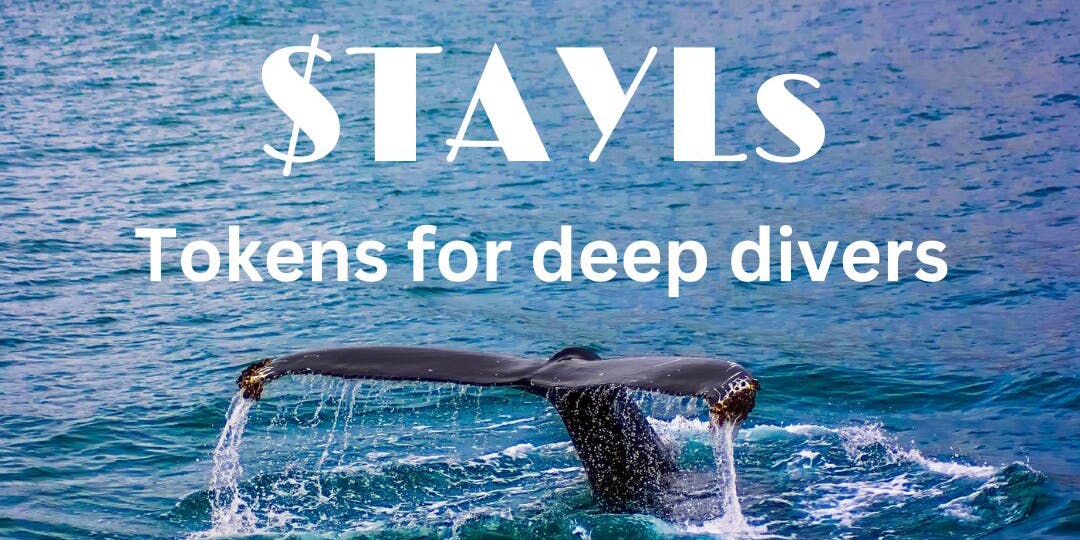Collect this post and receive an airdrop of 200 free Taylor Tokens ($TAYL) to your wallet. To learn what Taylor Tokens are, read to the bottom of the post.
After studying Web3 for several years and having written two books on the subject, I've come to the conclusion that Web3 is definitely the next phase of the internet. That doesn't mean that everyone will onboard onto Web3 right away. It's likely that some net citizens will linger in Web2 for a while. In fact, most of us will likely have one foot in Web2 and one foot in Web3 until there's no sense pretending Web2 shouldn't be relegated to history. That could be a decade, or more.

I think there are several good reasons why Web3 is the future of the internet. That doesn't mean it will be perfect, but it will be better than what we have now. Here are 5 reasons the future of the internet is Web3.
The ball is rolling - Some people seem to think that Web3 is a pipedream, something conjured up in the middle of the night a couple of months ago in the back room of a neighborhood bar named The Bada Bing. Truth is, the concept has been around since 2014. It isn't going anywhere.
People want a decentralized internet - As I've argued in both Cryptosocial: How Cryptocurrencies Are Changing Social Media and Web3 Social: How Creators Are Changing the World Wide Web (And You Can Too!), the internet began as a decentralized Department of Defense asset. The World Wide Web was decentralized before Big Tech took it over. Most people prefer a decentralized internet. Even if they don't know what that means, once they get a taste of the benefits, they'll want the internet to be decentralized.
Web3 promises, and can deliver, enhanced security and privacy - Talk to anyone online long enough and you'll find that they have concerns about how their data is used, whether it is secure, and what is being done with their data when they aren't looking. Web3 answers these concerns.
Web3 offers better monetization options for creators - Creators cannot create without monetizing their content. Web3's monetization options are a step up from those in Web2.
Web3 brings creators and their fans closer together - Web3 tools close the gap between creator and fan. When both creators and fans discover this truth, they'll both want the benefits of building a community where creator and fan can connect on a deeper level. We're just a few steps away from that now.
The journey into Web3 will not involve a big splash, just as the migration from Web1 to Web2 did not happen overnight. The transition from Web1 to Web2 took place over several years and through several significant developments. I outline this process in Web3 Social. By the same token, the transition from Web2 to Web3 will be gradual and involve several different steps that benefit creators and fans in many ways.
4 Pillars of Content Monetization in Web3
Web3 is about more than content monetization, but content monetization is a big aspect to the emerging Web3 ecosystem. Here are the 4 pillars to Web3 content monetization:
Rewards - On platforms like Hive, Minds, and some others, content creators earn through rewards. Rewards are either earned by upvotes, tips, or some combination of rewards and tips. While there are problems associated with this create2earn model, it is popular and simple to implement.
Non-fungible tokens (NFTs) - NFTs were a craze for a while, then the enthusiasm died down. However, they are still good for monetizing content. Creators will do better if they give their NFTs some type of utility. The downside is they have to get good at selling. NFTs also give creators the ability to earn royalties on secondary sales.
Decentralized autonomous organizations (DAOs) - DAOs represent a whole new way of monetization for content creators. Some DAOs will pay creators for providing a service in the same way that a business does. In those cases, the DAO may pay with a legacy cryptocurrency such as ETH or BTC or with fiat currency. In other cases, the DAO may pay the creator with its native token. In the latter case, the token may contain some currency value and is tradeable with other currencies on exchanges. In other cases, it may be nothing more than a governance token. Some DAOs may pay in a combination of native token and legacy token. Other DAOs offer bounties or quests that allow creators a chance to earn by completing specific tasks the DAO wants accomplished. Another payment model involves staking. Creators may earn a stake in the DAO or staked cryptocurrencies for their contributions to the DAO, which could be anything from providing content to participating in events and activities.
Social tokens - Social tokens represent a self-monetization technique where creators use a platform or protocol to create social tokens, which they can then distribute to others by creating bounties or rewarding fans for specific actions. Social tokens can also be listed on exchanges, staked, or provide some kind of utility, which could create a market for said tokens allowing the creator to earn by subsequent rises in value of their personal tokens.
It remains to be seen which of these monetization methods will be the dominant one going forward. Each has their pros and cons. I'd be willing to bet DAOs are here to stay, and it's likely that rewards will be an earning method over the long run. NFTs will likely see renewed interest during the next bull run, but as a long-term play, they may not have much earning power unless creators make NFTs with some sort of utility. The utility will drive the earning power. Social tokens are likely hit or miss as the SEC seems to have its sights set on destroying any value social tokens may have for creators.
For me personally, I'm experimenting with all four of these monetization tactics. So far, rewards have proven to be the best earning source for me, but I've been working that model longer than the others.
I've managed to earn a little bit of DAO money, but some of my tokens, such as CABIN, can't be sold. I've begun exploring literary NFTs, and so far they've done well in the short time that I've been creating them, mostly on Layer-2 solutions Optimism and Polygon. Whether income from NFTs will be consistent for me will depend on whether I can attract a loyal following and fanbase who are into collecting NFTs. I've noticed that NFT collectors and rewards chasers are two very different audiences, so focusing efforts on both sides of that coin makes sense. Recently, I issued my own personal token, and I'm anxious to see how that plays out in the next few months.
Earning power in Web3 will be predicated in large part on creators' ability to build and maintain a community around their creations. Frankly, as a committed introvert, that scares the hell out of me, but I'm willing to give it a try.
Check Out Some Ways I Monetize My Content
The following are not all Web3 monetization platforms or protocols, but I list these as an invitation to check out my content, in both Web2 and Web3.
Cryptosocial: How Cryptocurrencies Are Changing Social Media
Cryptosocial: How Cryptocurrencies Are Changing Social Media was my first book on Web3 social media. Some of the information is outdated, but it's still a good book for people new to blockchain technology and Web3 social media. Heavily referenced.
Online Bookstores
The Publisher
Interactive Online eBook
Web3 Social: How Creators Are Changing the World Wide Web (And You Can Too!)
Web3 is emerging to expand the opportunities for creators by delivering tools that help them regain their content freedom, monetize their content better, safeguard their personal data, and fight back against censorship.
At Amazon
Audiobook
NFT Book
Diamonds and Pearls: The History of the Top 10 Cryptocurrencies

Taylor Tokens: Getcha Some
Web3 Publishing Platforms
Feel free to connect with me on the following Web3 publishing platforms.
Publish0x (Note: Publish0x isn't technically a Web3 platform, but it is crypto-focused. If you join Publish0x using this link, I'll get a small portion of tips, but my portion will come from the platform's share rather than yours, and at no expense to you.)
Show Me Some Love!
If you like this post, show me some love. There are three ways to show me that you enjoyed reading this issue of Web3 Writings.
Share this post with your friends
Subscribe to the channel
Collect this Post













